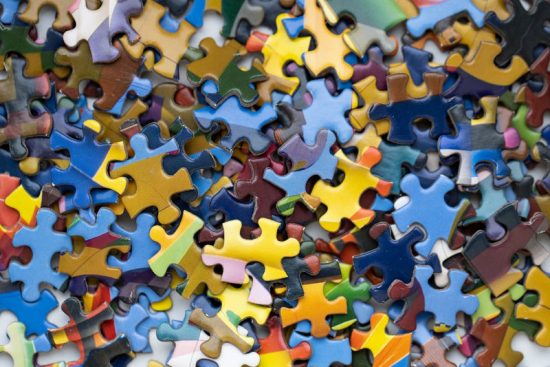This page may contain affiliate links. If you purchase something through one of the links, we may receive a commission at no extra charge to you. Still, we would include only products we actually trust and believe will be helpful for you.
Puzzlers often ask how much time it would take to complete a jigsaw puzzle with X number of pieces (e.g. 500 or 1000).
To answer that question, we have performed some research online. The goal was to find out how many hours people spend to solve puzzles.
Following are the research details.
Note: we didn’t use any puzzle data provided by articles. Instead, we utilized data from people who shared their actual experience online.
Puzzle Solving Time vs Number of Pieces
After gathering the puzzle completion times reported by people, we plotted these numbers against the quantity of pieces. The main aim was to see if the data follows a certain trend (which was the case).

The trend-line drawn in the chart fits the data quite well, as the R-Squared coefficient was 0.99+.
Based on the graph, the data is only negligibly exponential (basically linear). In other words, doubling the number of puzzle pieces will generally double the solving time.
Thanks to the trend plot, we got a nice equation that can be used to calculate how long it takes on average to finish a puzzle with any number of pieces. The equation is as follows:
y = 8E-08x2 + 0.0085x
It’s important to note though that due to the limited data for puzzles beyond 5000 pieces, the solving times after that point may not be very accurate.
Expected Solving Time of Jigsaw Puzzles
The solving times for popular puzzle sizes are as follows:
| # Puzzle Pieces | Solving Time Expected (hrs) | Solving Time Range (hrs) |
| 500 | 4 | 2-7 |
| 1000 | 9 | 5-12 |
| 2000 | 17 | 11-24 |
| 5000 | 45 | 36-64 |
The expected solving times are calculated using the equation of data trend-line, while the ranges are based on the actual data used in our research.
It’s worth noting also that the numbers in the second column are rounded. That’s why the increase in solving time with puzzle size may appear to be not linear (but it actually is).
Research Process
We utilized almost 60 data points in the research. A big reason for this low amount of data is because many people state their solving time in days or weeks rather than actual hours (which essentially makes the number useless for us). We also eliminated some clear outliers to have more representative data.
The majority of data used is for puzzles with 500 and 1000 pieces (which are the most popular).
The research data was gathered mostly through posts on Reddit forums. We also found some in customer questions section for jigsaw puzzles (Amazon) and video descriptions for puzzle time lapse (YouTube).
Additionally, we ignored any data where more than one individual was working on the puzzle.
The collected data was plotted as solving time versus number of pieces. Then, a trend-line was added and used to find the equation for calculating puzzle completion times. Also, we relied on the actual data numbers (rather than the trend) to get the expected solving time range for some popular puzzle sizes.
Conclusion
As indicated, the change in the solving time for jigsaw puzzles seems to be pretty much linear with respect to the number of pieces.
If a 1000-piece puzzle takes you around 8 hours to finish, you will probably spend 16 hours on a puzzle with 2000 pieces.
To make calculating the solving time easier, we have created this puzzle time calculator. It simply uses the equation we found in the chart above. You just need to input the number of pieces to get the expected time to complete the puzzle. Be sure to check it out.


